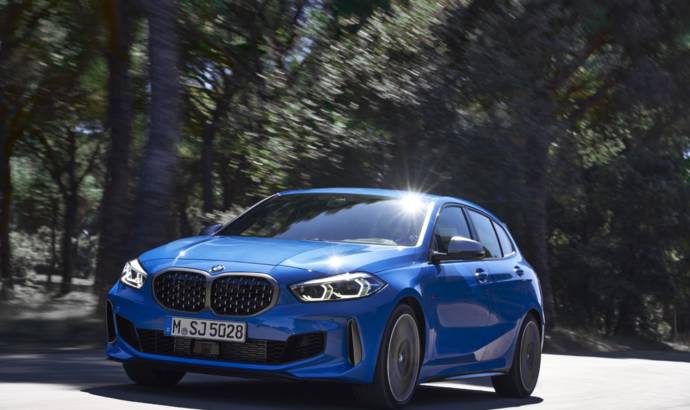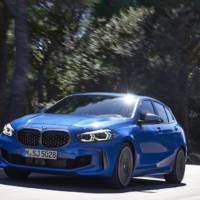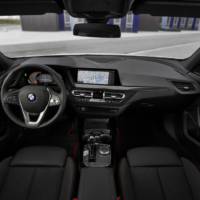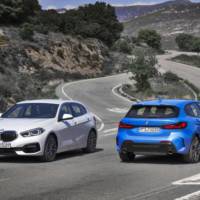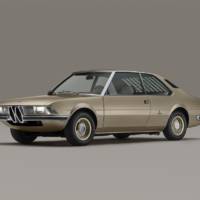BMW is making an important step in the compact segment with the introduction of the new 1 Series. The new generation, now in its third generation, features a dynamic design, roomier interior, a raft of technologies as well as BMW’s trademark agility and performance.
It features a shorter bonnet and significantly more space within a footprint almost identical to that of its predecessor. At 4,319 millimetres, the new BMW 1 Series is five millimetres shorter, 34 millimetres wider and 13 millimetres higher. At 2,670 millimetres, the wheelbase is 20 millimetres shorter.
There have been a number of design changes including a new headlight arrangement, a more wedged shaped silhouette and a pronounced ‘shark nose’. At the front, the BMW kidney grille is larger and, for the first time in this model range, the kidneys merge in the middle. The range-topping BMW M135i xDrive features a distinctive grille with a mesh design instead of the classical bars.
The BMW 1 Series features a distinctive window graphic enhanced by two character lines. One runs below the door handles from the front wheels to the rear wings, while the other starts in the lower part of the front door before lifting towards the rear quarter. In addition, the greenhouse is elongated with the traditional Hofmeister Kink incorporated into the C pillar.
The front-wheel-drive architecture with transverse engines and a lower centre tunnel offers the occupants more space than in the predecessor. This applies especially to those in the rear seats. Access is easier and there is an extra 33 millimetres of kneeroom available. Rear headroom is up by 19 millimetres when the outward opening panoramic sunroof is fitted. Rear passengers also enjoy 13 millimetres more elbowroom, while the driver and front passenger get extra 42 millimetres in this respect. Luggage compartment capacity rises by 20 litres to 380 litres (1,200 litres with the rear seat bench folded down).
The interior has more space and features high-quality materials throughout, driver-focused controls and innovative details, such as backlit trim strips. The BMW 1 Series with optional BMW Live Cockpit Professional features the new BMW Operating System 7.0 – with optional gesture control – which can be controlled via 10.25 inch screen.
The new BMW 1 Series is available with a wide range of new light-alloy wheels, including – for the first time – the option of wheels with a diameter of 19 inches. The SE model has 16-inch light-alloy wheels as standard. The Sport models feature 17-inch light-alloy wheels whilst the M Sport moves up to 18-inch light-alloy wheels as standard. The BMW M135i xDrive comes with bespoke polished 18-inch light-alloys, whilst newly designed 19-inch light-alloy wheels are optionally available for this and the M Sport model.
For the first time a panoramic roof is available as an option for the BMW 1 Series. With a 0.7m glass area, the roof features an electrically operated roller blind to provide shading along with a net wind deflector to reduce noise when open.
The new BMW 1 Series features the actuator contiguous wheel slip limitation (ARB) technology used in the BMW i3s. This is the first time it has been used in a combustion-engine car and it has the effect of significantly improving traction when pulling away, cornering or when driving in the wet. The system works in close tandem with the DSC system to significantly reduce power understeer.
ARB technology and BMW Performance Control also feature on the BMW 120d xDrive and the BMW M135i xDrive, which are both equipped with BMW xDrive intelligent all-wheel drive as standard. This can split drive power 50:50 if necessary and is designed to ensure predictable handling in all driving situations. This applies even if the Driving Experience Control switch is set to Sport mode, DTC is selected or DSC is deactivated.
In Comfort or Eco Pro mode, drive is split as required, while keeping fuel consumption as low as possible. Fuel economy is therefore improved without any discernible impact on driving dynamics or traction. As well as the all-wheel-drive system, standard specification for the BMW M135i xDrive includes a newly developed mechanical Torsen limited-slip differential, which gives the car an even sportier edge.
The differential is integrated into the standard eight-speed Steptronic Sport transmission on the BMW M135i xDrive and also features a Launch Control mode that puts the full peak torque of 450Nm on tap in first and second gear.
In the 1.5-litre three-cylinder engine powering the entry level BMW 118i, modifications have cut CO2 emissions by 29g/km at the same time as boosting maximum power output by 4hp to 140hp. The power unit, which is five kilograms lighter than the one it replaces, generates peak torque of 220Nm. The BMW 118i accelerates from zero to 62mph in 8.5 seconds and goes on to a top speed of 132mph. It posts combined fuel consumption of 47.1-40.4mpg with CO2 emissions of 123-114g/kg.
The newly developed 2.0-litre unit under the bonnet of the M135i xDrive model is BMW Group’s most powerful four-cylinder petrol engine. It delivers 306hp with the help of BMW TwinPower Turbo technology and peak torque is 450Nm. It accelerates from zero to 62mph in 4.8 seconds, while top speed is limited to 155mph. The M135i xDrive returns 35.3-34.4mpg and emits 157-155g/km of CO2.
The BMW 116d is powered by a 1.5-litre 116hp three-cylinder engine with a maximum torque of 270Nm, while returning 61.4-54.3mpg and emitting CO2 of 103-100g/km. This is sufficient for a top speed of 124mph and a zero to 62mph benchmark time of 10.3 seconds (10.1 seconds with the seven-speed Steptronic dual-clutch transmission).
The BMW 118d and 120d xDrive, which feature two-stage turbocharging, are powered by 2.0-litre four-cylinder diesel engines. The 118d returns 60.1-51.4mpg with CO2 emissions of 111-108 g/km. The output of the BMW 118d peaks at 150hp while maximum torque is 350Nm. The zero to 62mph sprint takes 8.5 seconds (8.4 seconds with eight-speed Steptronic transmission) and top speed is 135mph (134mph with Steptronic).
The BMW 120d xDrive features BMW xDrive intelligent all-wheel drive and the eight-speed Steptronic automatic transmission as standard. Its four-cylinder power unit produces 190hp and a peak torque of 400Nm. The 120d xDrive accelerates from zero to 62mph in 7.0 seconds reaching a top speed of 143mph. Combined fuel consumption is at 51.4-48.7mpg while emitting 119-117g/km CO2.

